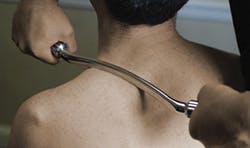Instrument Assisted Soft Tissues Massage (IASTM)
...i.e., that odd little metal instrument I use, explained
Dr. John O’Neil, DPT
Physical Therapists have used their hands to improve blood flow and break up restrictions or myofascial adhesions in injured soft tissue for quite some time, but sometimes our fingers alone can't detect your restrictions at deeper levels to treat the full range of restrictions. Because of this, several companies have now developed handheld tools to perform instrument-assisted soft-tissue mobilization made from a variety of materials. Stainless steel instruments have the highest resonation and make it easier to feel both local and broad areas of tissue restriction, which produces outcomes that are equal to, or better than, palpation by our hands.
What is a Myofascial Adhesion, anyway?
To conceptualize a myofascial adhesion, think of the myofascia as the T-shirt on your body. Normally, this "T-shirt" moves freely on you, and does not impede your movement. When there is a myofascial adhesion, it would be analogous to someone squeezing your sleeve tightly and anchoring it to your skin, and then being unable to turn your trunk, or lift your arm, secondary to the shirt impeding your movement. To further exacerbate the issue, these dysfunctional movement patterns can become your "new normal" way of moving which could lead to perpetuating the issue. Myofascial adhesions are just one of many reasons that certain movements of your body's tissues can become impaired.
IASTM has two main functions in your rehab process. These are to break up abnormal myofascial adhesions/scar tissue, and to reinitiate the first-stage healing in your body. This is done by creating microtraumas in the involved site which temporarily improves blood flow to the treatment area to begin laying down new collagen tissues and help improve your own body’s ability to repair itself.
The human body is very much a dynamic structure that is continuously breaking down old tissue and building up new ones. Although scar tissue is an essential end-goal in the healing process, it tends to be much less flexible than normal tissue. In the long run, adhered scar tissue can cause restricted motion, which leads a dysfunctional movement pattern, and then eventually pain. IASTM is one of the many ways Physical Therapists can help break up scar tissue/myofascial adhesions, and then work with you through therapeutic exercise to restore movement patterns that do not lead to dysfunction.

What does IASTM feel like… does it hurt?
IASTM should be a pain-free technique, which may cause some slight redness the following day. When used on a restricted area, it can have a sensation similar to the bumps experience when driving over a cobblestone road. On an unrestricted area, it feels quite smooth. In the past, it was thought that this technique needed to be performed vigorously, and cause extensive bruising to be effective, but this has since been disproven. Again, the way we perform IASTM here should not cause any pain, and very rarely causes redness or bruising.
 Is it right for me?
Is it right for me?
The use of IASTM is one of the many techniques that we as Physical Therapists have here at Purcellville Orthopedic Physical Therapy use to improve the mobility of your tissues to help promote a restriction-free and non-pathological movement pattern. We would very much appreciate if you stop on by to see if IASTM or Physical Therapy can help you get back to life!

